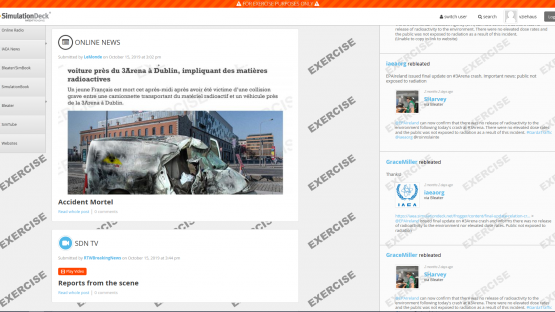“OMG #Dublin will be a radioactive zone due to the #3ArenaCrash!! @EPAIreland @iaeaorg what should we do?? We need answers! This is another #Chernobyl!” This fabricated social media post is one of hundreds that public information officers in Ireland had to assess in an exercise using the IAEA’s Social Media Simulator. The exercise was developed to help countries strengthen their emergency social media response capabilities during a simulated perceived emergency.
The Irish Environmental Protection Agency (EPA) stepped up to support this first-time Convention Exercise using SimulationDeck, an internet simulator and exercise management tool that the IAEA adapted for use in nuclear emergency exercises and training. “We all felt that using a tool that reflected ‘real life’ social media provided a very rich learning environment,” highlighted Ciara Hilliard, Programme Officer of the Emergency Preparedness Unit at EPA Ireland. “It gave a realistic example of the potential pressures of communicating in an emergency.”
The social media exercise takes place online yet can only be seen by the teams taking part in the exercise in Dublin and Vienna. All the exercise “players” view a monitoring platform that tracks simulated social media posts. The exercise begins with initial public concern, a trending story about a traffic accident involving a van carrying radioactive material near a concert arena in Dublin. The initial posts were soon followed by photographs of the vehicle’s radiation placards that trigger a surge in posts.
The public is demanding answers, some accounts circulate rumours and media seek official responses. Adding to the complexity, and realism, the simulated social media posts include multilingual messages, news articles, and news video clips. Through it all, the emergency communicators need to determine the facts and coordinate with their technical teams to swiftly issue accurate, easily understandable public safety messages on the appropriate channels. In coordination with emergency responders, the communicators also adapt their messages throughout the exercise to keep pace with shifting public concerns and circumstances.
“It is vital to be able to test emergency communications on social media since it is a major part of any effective response in an emergency,” said Peter Kaiser, IAEA Crisis Communications Adviser. “We developed a secure platform that allows public information teams to realistically engage with a simulated public via social media during a fictional emergency, enabling emergency procedures to be tested and evaluated with no risk of alarming the public.”
The IAEA Incident and Emergency Centre (IEC) is planning to further test SimulationDeck in internal and national exercises, as well as in training workshops.





